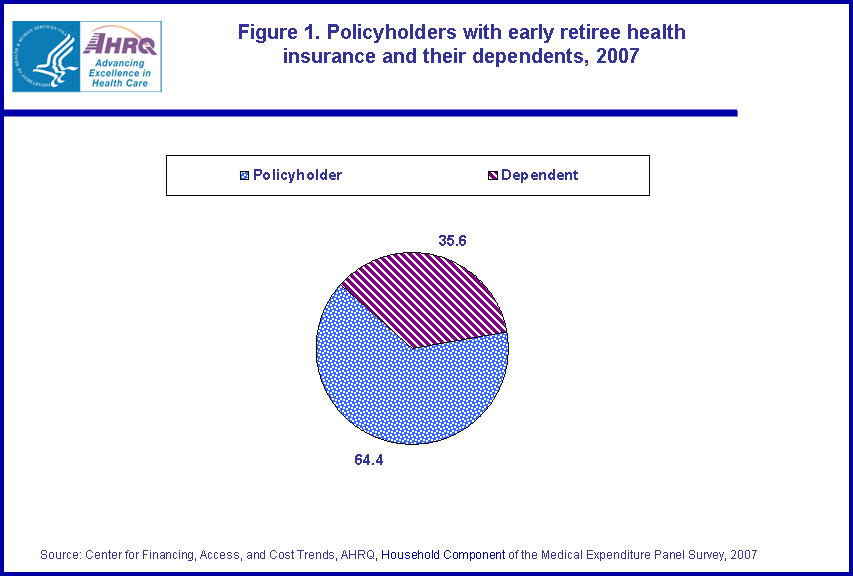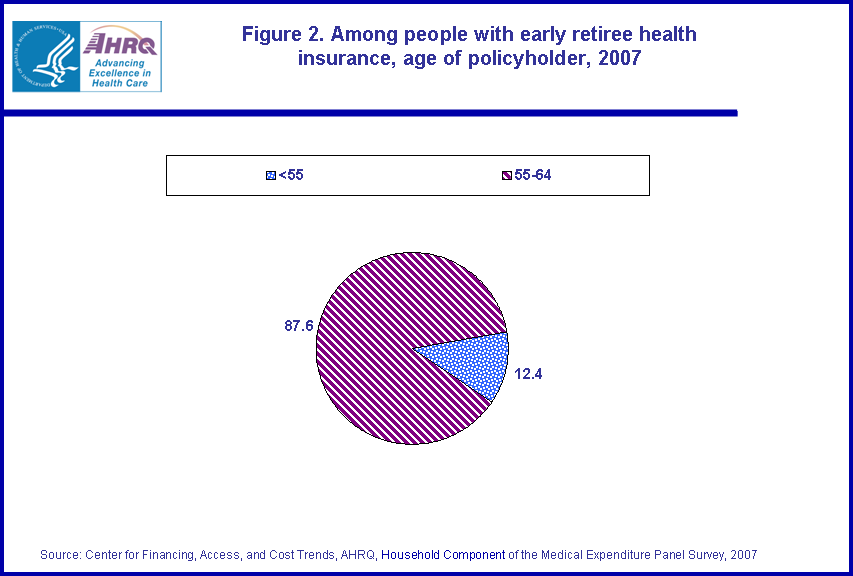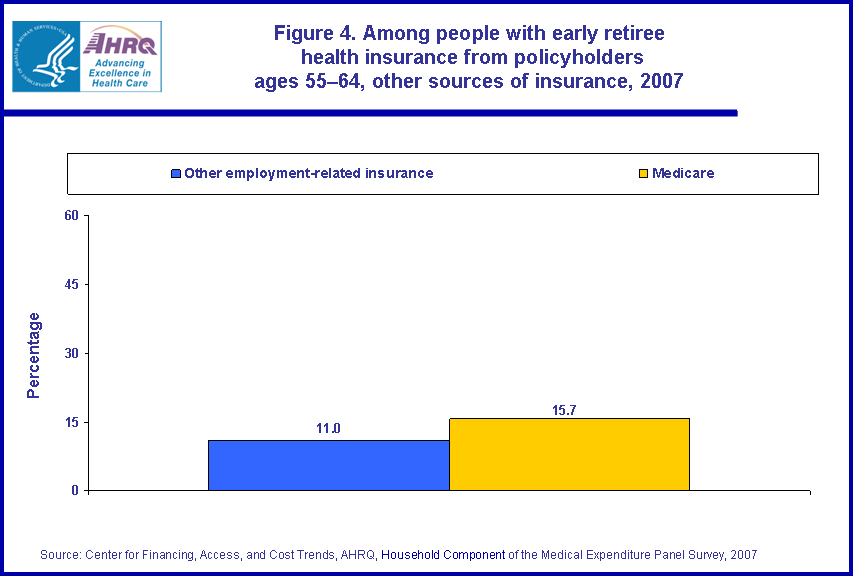
|
|
Font Size:
|
||||
|
|
|
|
||||
STATISTICAL BRIEF #296:
Early Retiree Health Insurance, 2007
Highlights
- Among people with early retiree health insurance, 64.4 percent were policyholders (early retirees) and 35.6 percent were dependents.
- In 2007, 6.5 million people had early retiree health insurance from policyholders age 55 to 64.
- Among people with early retiree health insurance from policyholders ages 55 to 64, 46.3 percent obtained it from a private sector employer, 37.0 percent from state and local government employers, 13.6 percent from the federal government, and 3.1 percent did not report the type of employer.
Introduction
Some employers provide health insurance to workers who retire before age 65, which is commonly called early retiree health insurance. Early retiree health insurance can cover former workers and their dependents. Beginning in 2010, the Early Retiree Reinsurance Program, established under the Patient Protection and Affordable Care Act, provides reimbursement to sponsors of plans for a portion of the health care costs of early retirees age 55 and older and their dependents who are not eligible for Medicare.This Statistical Brief describes people who reported early retiree health insurance while part of the U.S. civilian noninstitutionalized population at any time in 2007. Both retired workers and their dependents are included. Estimates in this Brief are based on data from the Household Component of the Medical Expenditure Panel Survey (MEPS-HC) for 2007. All differences between estimates discussed in the text are statistically significant at the 0.05 level.
Findings
In 2007, 7.4 million people reported having early retiree health insurance any time during the year. As shown in figure 1, among people with early retiree health insurance, 64.4 percent were policyholders and 35.6 percent were dependents.As shown in figure 2, 87.6 percent (or 6.5 million people), had early retiree insurance from policyholders ages 55-64, and 12.4 percent had early retiree insurance from policyholders age 54 or younger.
Among people with early retiree health insurance from policyholders ages 55-64, 46.3 percent obtained it from a private sector employer, 37.0 percent from state and local government employers, and 13.6 percent from the federal government, including reported military retirees (figure 3). Household respondents did not know the type of employer for 3.1 percent of people with early retiree health insurance.
Early retirees and their dependents may have multiple sources of insurance. An early retiree may obtain a new job from an employer that offers insurance to current employees, or an early retiree's spouse may continue to obtain insurance from his or her own current employer. As shown in figure 4, 11.0 percent of people with early retiree health insurance from policyholders ages 55-64 also had other employment-related insurance.
Early retirees and their dependents may also have Medicare coverage because of a disability, and some dependents may be age 65 or older and qualify for Medicare. As shown in figure 4, 15.7 percent of people with early retiree health insurance from policyholders ages 55-64 also had Medicare.
Data Source
The estimates in this Statistical Brief are based on data from the MEPS HC-113: 2007 Full Year Consolidated Data File, HC-111: 2007 Person Round Plan File, and HC-108: 2007 Jobs File.Definitions/Methodology
Early retiree insurance coverageFor at least one month in 2007, people with early retiree insurance coverage reportedly had (1) insurance from a job the policyholder retired from, (2) insurance from a job that ended due to illness or injury more than 3 years before the first MEPS interview, or (3) insurance through a deceased policyholder. Among MEPS sample members with insurance through jobs they reported retiring from, illness and injury is also often reported as an additional reason for leaving the job, and the 3-year threshold likely excludes health insurance through severance packages. Reported COBRA coverage was excluded, unless the COBRA coverage was from a job that ended more than 3 years before the first MEPS interview, which is beyond the time duration covered by COBRA. In addition, the policyholder must be under age 65 in at least one month they had the coverage, or if the policyholder was deceased the dependent must be under age 65.
Policyholder age
The age of the dependent was used if the policyholder was deceased.
Other employment-related insurance
Other employment-related insurance was defined as health insurance obtained through an employer or union, excluding early retiree insurance. It also included coverage through someone outside of the household or whose source was unknown, since both sources were likely to be employment-related. Individuals were classified as having employment-related health insurance if they had any of the above sources in a month they also had early retiree health insurance.
Medicare
Medicare beneficiaries had Medicare in at least one month in which they also had early retiree health insurance.
About MEPS-HC
MEPS-HC is a nationally representative longitudinal survey that collects detailed information on health care utilization and expenditures, health insurance, and health status, as well as a wide variety of social, demographic, and economic characteristics for the U.S. civilian noninstitutionalized population. It is cosponsored by the Agency for Healthcare Research and Quality and the National Center for Health Statistics.For more information about MEPS, call the MEPS information coordinator at AHRQ (301) 427-1656 or visit the MEPS Web site at http://www.meps.ahrq.gov/.
References
For information on the Early Retiree Reimbursement Program, see the following website of the Department of Health and Human Services, Office of Consumer Information and Insurance Oversight: http://www.hhs.gov/ociio/regulations/errp/index.htmlFor a detailed description of the MEPS-HC survey design, sample design, and methods used to minimize sources of nonsampling error, see the following publications:
Cohen, J. Design and Methods of the Medical Expenditure Panel Survey Household Component. MEPS Methodology Report No. 1. AHCPR Pub. No. 97-0026. Rockville, MD: Agency for Health Care Policy and Research, 1997. http://www.meps.ahrq.gov/mepsweb/data_files/publications/mr1/mr1.shtml
Cohen, S. Sample Design of the 1996 Medical Expenditure Panel Survey Household Component. MEPS Methodology Report No. 2. AHCPR Pub. No. 97-0027. Rockville, MD: Agency for Health Care Policy and Research, 1997. http://www.meps.ahrq.gov/mepsweb/data_files/publications/mr2/mr2.shtml
Cohen, S. Design strategies and innovations in the Medical Expenditure Panel Survey. Medical Care, July 2003: 41(7) Supplement: III-5-III-12.
Suggested Citation
Hill, S.C. Early Retiree Health Insurance, 2007. Statistical Brief #296. October 2010. Agency for Healthcare Research and Quality, Rockville, MD. http://www.meps.ahrq.gov/mepsweb/data_files/publications/st296/stat296.shtmlAHRQ welcomes questions and comments from readers of this publication who are interested in obtaining more information about access, cost, use, financing, and quality of health care in the United States. We also invite you to tell us how you are using this Statistical Brief and other MEPS data and tools and to share suggestions on how MEPS products might be enhanced to further meet your needs. Please e-mail us at mepspd@ahrq.gov or send a letter to the address below:
Steven B. Cohen, PhD, Director
Center for Financing, Access, and Cost Trends
Agency for Healthcare Research and Quality
540 Gaither Road
Rockville, MD 20850
 |
||||||||||||||||||||
|
||||||||||||||||||||
|
|
||||||||||||||||||||
 |
||||||||||||||||||||
|
||||||||||||||||||||
|
|
||||||||||||||||||||
 |
||||||||||||||||||||
|
||||||||||||||||||||
|
|
||||||||||||||||||||
 |
||||||||||||||||||||
|
||||||||||||||||||||
|
|
||||||||||||||||||||


